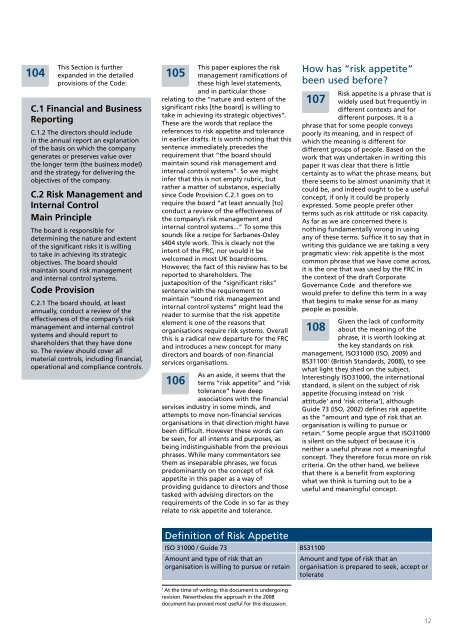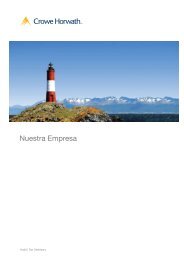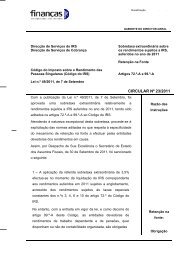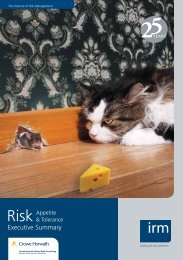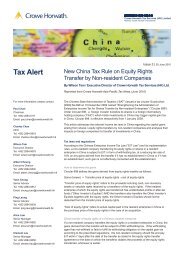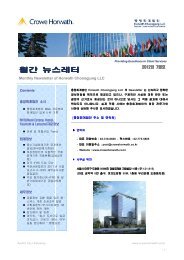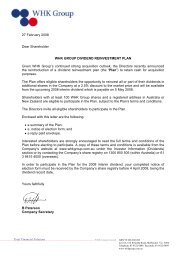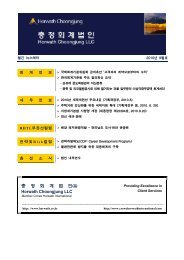Guidance Paper - The Institute of Risk Management
Guidance Paper - The Institute of Risk Management
Guidance Paper - The Institute of Risk Management
You also want an ePaper? Increase the reach of your titles
YUMPU automatically turns print PDFs into web optimized ePapers that Google loves.
104<br />
This Section is further<br />
expanded in the detailed<br />
provisions <strong>of</strong> the Code:<br />
C.1 Financial and Business<br />
Reporting<br />
C.1.2 <strong>The</strong> directors should include<br />
in the annual report an explanation<br />
<strong>of</strong> the basis on which the company<br />
generates or preserves value over<br />
the longer term (the business model)<br />
and the strategy for delivering the<br />
objectives <strong>of</strong> the company.<br />
C.2 <strong>Risk</strong> <strong>Management</strong> and<br />
Internal Control<br />
Main Principle<br />
<strong>The</strong> board is responsible for<br />
determining the nature and extent<br />
<strong>of</strong> the significant risks it is willing<br />
to take in achieving its strategic<br />
objectives. <strong>The</strong> board should<br />
maintain sound risk management<br />
and internal control systems.<br />
Code Provision<br />
C.2.1 <strong>The</strong> board should, at least<br />
annually, conduct a review <strong>of</strong> the<br />
effectiveness <strong>of</strong> the company’s risk<br />
management and internal control<br />
systems and should report to<br />
shareholders that they have done<br />
so. <strong>The</strong> review should cover all<br />
material controls, including financial,<br />
operational and compliance controls.<br />
This paper explores the risk<br />
105 management ramifications <strong>of</strong><br />
these high level statements,<br />
and in particular those<br />
relating to the “nature and extent <strong>of</strong> the<br />
significant risks [the board] is willing to<br />
take in achieving its strategic objectives”.<br />
<strong>The</strong>se are the words that replace the<br />
references to risk appetite and tolerance<br />
in earlier drafts. It is worth noting that this<br />
sentence immediately precedes the<br />
requirement that “the board should<br />
maintain sound risk management and<br />
internal control systems”. So we might<br />
infer that this is not empty rubric, but<br />
rather a matter <strong>of</strong> substance, especially<br />
since Code Provision C.2.1 goes on to<br />
require the board “at least annually [to]<br />
conduct a review <strong>of</strong> the effectiveness <strong>of</strong><br />
the company’s risk management and<br />
internal control systems...” To some this<br />
sounds like a recipe for Sarbanes-Oxley<br />
s404 style work. This is clearly not the<br />
intent <strong>of</strong> the FRC, nor would it be<br />
welcomed in most UK boardrooms.<br />
However, the fact <strong>of</strong> this review has to be<br />
reported to shareholders. <strong>The</strong><br />
juxtaposition <strong>of</strong> the “significant risks”<br />
sentence with the requirement to<br />
maintain “sound risk management and<br />
internal control systems” might lead the<br />
reader to surmise that the risk appetite<br />
element is one <strong>of</strong> the reasons that<br />
organisations require risk systems. Overall<br />
this is a radical new departure for the FRC<br />
and introduces a new concept for many<br />
directors and boards <strong>of</strong> non-financial<br />
services organisations.<br />
As an aside, it seems that the<br />
106 terms “risk appetite” and “risk<br />
tolerance” have deep<br />
associations with the financial<br />
services industry in some minds, and<br />
attempts to move non-financial services<br />
organisations in that direction might have<br />
been difficult. However these words can<br />
be seen, for all intents and purposes, as<br />
being indistinguishable from the previous<br />
phrases. While many commentators see<br />
them as inseparable phrases, we focus<br />
predominantly on the concept <strong>of</strong> risk<br />
appetite in this paper as a way <strong>of</strong><br />
providing guidance to directors and those<br />
tasked with advising directors on the<br />
requirements <strong>of</strong> the Code in so far as they<br />
relate to risk appetite and tolerance.<br />
How has “risk appetite”<br />
been used before<br />
<strong>Risk</strong> appetite is a phrase that is<br />
107 widely used but frequently in<br />
different contexts and for<br />
different purposes. It is a<br />
phrase that for some people conveys<br />
poorly its meaning, and in respect <strong>of</strong><br />
which the meaning is different for<br />
different groups <strong>of</strong> people. Based on the<br />
work that was undertaken in writing this<br />
paper it was clear that there is little<br />
certainty as to what the phrase means, but<br />
there seems to be almost unanimity that it<br />
could be, and indeed ought to be a useful<br />
concept, if only it could be properly<br />
expressed. Some people prefer other<br />
terms such as risk attitude or risk capacity.<br />
As far as we are concerned there is<br />
nothing fundamentally wrong in using<br />
any <strong>of</strong> these terms. Suffice it to say that in<br />
writing this guidance we are taking a very<br />
pragmatic view: risk appetite is the most<br />
common phrase that we have come across,<br />
it is the one that was used by the FRC in<br />
the context <strong>of</strong> the draft Corporate<br />
Governance Code and therefore we<br />
would prefer to define this term in a way<br />
that begins to make sense for as many<br />
people as possible.<br />
Given the lack <strong>of</strong> conformity<br />
108 about the meaning <strong>of</strong> the<br />
phrase, it is worth looking at<br />
the key standards on risk<br />
management, ISO31000 (ISO, 2009) and<br />
BS31100 1 (British Standards, 2008), to see<br />
what light they shed on the subject.<br />
Interestingly ISO31000, the international<br />
standard, is silent on the subject <strong>of</strong> risk<br />
appetite (focusing instead on ‘risk<br />
attitude’ and ‘risk criteria’), although<br />
Guide 73 (ISO, 2002) defines risk appetite<br />
as the “amount and type <strong>of</strong> risk that an<br />
organisation is willing to pursue or<br />
retain.” Some people argue that ISO31000<br />
is silent on the subject <strong>of</strong> because it is<br />
neither a useful phrase not a meaningful<br />
concept. <strong>The</strong>y therefore focus more on risk<br />
criteria. On the other hand, we believe<br />
that there is a benefit from exploring<br />
what we think is turning out to be a<br />
useful and meaningful concept.<br />
Definition <strong>of</strong> <strong>Risk</strong> Appetite<br />
ISO 31000 / Guide 73<br />
Amount and type <strong>of</strong> risk that an<br />
organisation is willing to pursue or retain<br />
BS31100<br />
Amount and type <strong>of</strong> risk that an<br />
organisation is prepared to seek, accept or<br />
tolerate<br />
1<br />
At the time <strong>of</strong> writing, this document is undergoing<br />
revision. Nevertheless the approach in the 2008<br />
document has proved most useful for this discussion.<br />
12


